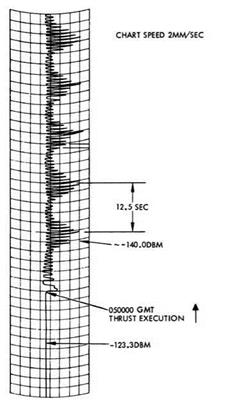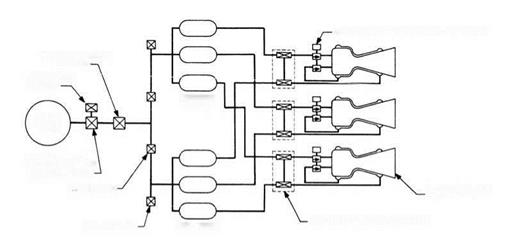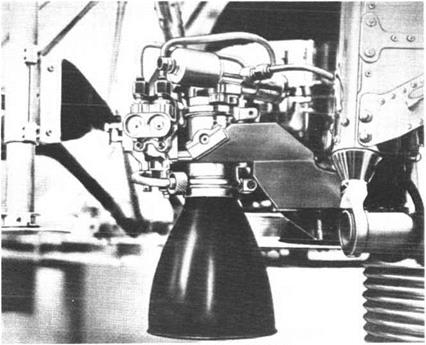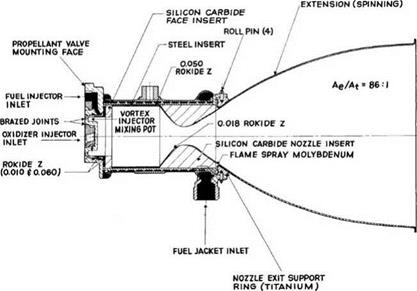TUMBLING OUT OF CONTROL
Since Surveyor 2 was essentially complete at the time of the first mission, it was identical to its predecessor. Upon the surprising success of Surveyor 1, NASA opted not to postpone the second mission to install scientific instruments. It duly lifted off from Pad 36A at 12:32:00 GMT on 20 September 1966 on a direct-ascent trajectory with the objective of landing in Sinus Medii.5 In general, this was much rougher – looking than the area in Oceanus Procellarum assigned to Surveyor 1. This time, it was intended to operate the downward-looking TV camera during the approach in order to gain a sense of perspective of the landing site.
The translunar injection trajectory would intercept the Moon just northeast of the crater Mosting on the western margin of Sinus Medii, 142 km from the centre of the 60-km target circle. The sequence for the 31.5-ft/sec midcourse manoeuvre began at T+15h 42m with an interrogation to verify the readiness of the vehicle’s systems. At 16h 12m the spacecraft initiated a roll of +75.3 degrees, followed 5 minutes later by a yaw of +11.5 degrees. This successfully oriented the vehicle for the burn. The burn was started on command at 16h 28m but vernier no. 3 failed to ignite. After the specified duration of 9.8 seconds, the system shut down. The asymmetric thrust had left the vehicle spinning about one axis at 1.22 revolutions per second, with this axis precessing in 12 seconds. This saturated the gyros in the minus pitch, plus yaw and minus roll directions. The flight control system set about regaining stability utilising the attitude control thrusters. After 7 minutes the precession had been cancelled. But after 14 minutes, with a residual spin around the main axis of 0.85 revolutions per second and with the jets having consumed half of the nitrogen supply, a command was sent from Earth to inhibit the system and save the remaining gas for use in the event that the problem involving vernier no. 3 could be overcome, at which time the verniers would be used to stabilise the vehicle.
![]() In fact, this was site I-P-5 on Lunar Orbiter 1’s target list.
In fact, this was site I-P-5 on Lunar Orbiter 1’s target list.
 Deep Space Instrumentation Facility automatic gain control variations served to document the initial tumbling of the Surveyor 2 spacecraft.
Deep Space Instrumentation Facility automatic gain control variations served to document the initial tumbling of the Surveyor 2 spacecraft.
 SOLENOID-OPERATED PROPELLANT VALVE
SOLENOID-OPERATED PROPELLANT VALVE
|
|
|
|
 |
|
![]()
![]()
RELIEF VALVE
FUEL TANKS
A simplified depiction of the Surveyor spacecraft’s vernier propulsion system.
|

Detail of an engine of the Surveyor spacecraft’s vernier propulsion system.
The solar panel was unable to provide power while the vehicle was tumbling, so time was of the essence. It was apparent that verniers no. 1 and 2 had delivered the specified thrust during the manoeuvre, but no. 3 had delivered no thrust at all. It was decided to command a 2-second firing in an effort to clear vernier no. 3. This was done at 18h 56m and again at 19h 18m, but without success. In case the fault was a stuck flow regulator valve, the system was commanded to pulse five times for a duration of 0.2 seconds at 5 minute intervals starting at 31h 12m and then attempt another 2-second firing – again in vain. This sequence was repeated at 26h 28m, 37h 29m, 38h 45m and 39h 45m – each time with no effect. At 41h 11m an attempt was made to fire the engine at a ‘harder’ start and a higher thrust for 2 seconds. Because the other two verniers were participating in these tests, by this point the spin rate had increased to 1.54 revolutions per second. At 43h 13m a new sequence was initiated in which the engines were pulsed five times for 0.2 second with 1 minute between firings, as a preliminary to a 20-second firing. Although this time the temperature of vernier no. 3 increased somewhat, the engine did not respond properly.
Although the spacecraft was tumbling out of control, it was decided to undertake a series of tests to obtain engineering data on its subsystems, concluding at 45h 02m with a command to trigger the retro sequence. Contact was lost 30 seconds into the retro-rocket’s burn. The inert vehicle would have struck the Moon several hundred kilometres southeast of Copernicus.
The post-flight investigation by propulsion engineers of JPL, NASA, Hughes and Thiokol decided that there had been no combustion in vernier no. 3 at the attempted midcourse manoeuvre, and that although fuel had flowed into the engine the oxidiser had not. As it was not possible to determine the root cause of the failure, a number of revisions were introduced for Surveyor 3 designed to provide better diagnostics of the vernier propulsion system, both during pre-flight testing and in flight.











